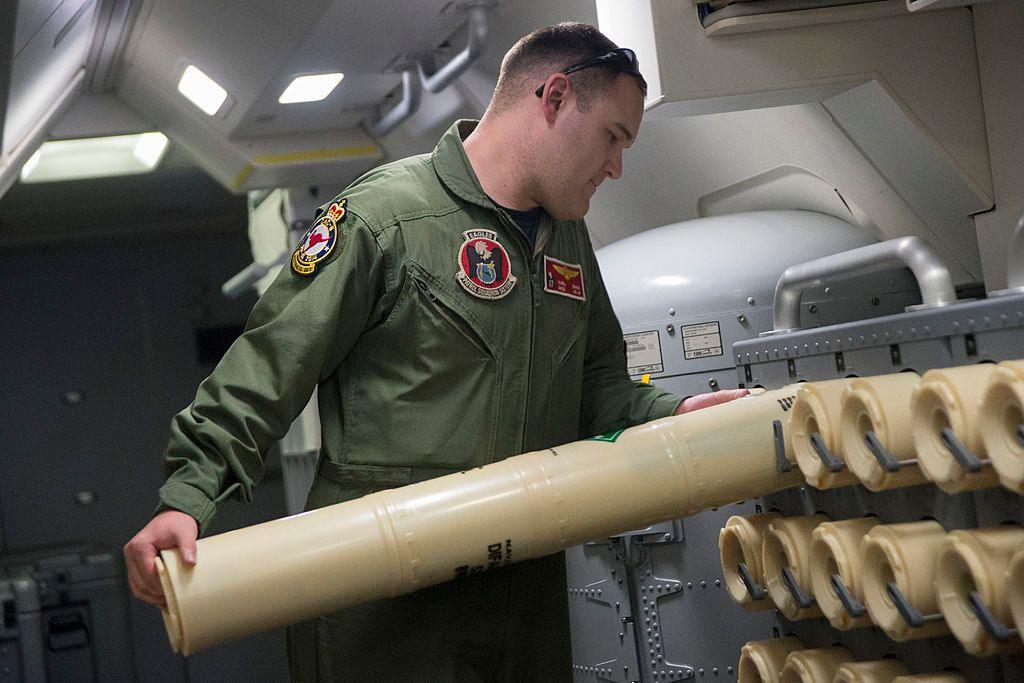Suspected Russian tracking device found by scuba divers

Tim Smith-Gosling was the diver who found the device in the Skomer Marine Conservation Zone
- Published
A team of litter-picking scuba divers have recovered what is believed to be a Russian tracking device off the Welsh coast.
Divers from Neptune's Army of Rubbish Cleaners (NARC) discovered the object on 15 November during a routine dive in the Skomer Marine Conservation Zone, off Wooltack Point in Pembrokeshire.
The team initially assumed the device was part of a navigational marker, but later suspected it resembled a sonobuoy - an acoustic monitoring device, often used to detect submarines.
An independent defence analyst said he was "confident" the recovered object was an imploded Russian RGB-1A sonobuoy.
Dave Kennard, NARC chairman, said the object was discovered wedged in a gulley by volunteer diver Tim Smith-Gosling.
After further inspection and research, including discussions with colleagues at the Port Authority Waterway, the divers concluded the item bore similarities to sonobuoys used for underwater detection.
The device, described by Mr Kennard as "battered," measures roughly 120cm (50in) in length and weighs about 15kg (2.4 stone).
It was recovered using a lifting bag before being brought to the surface.
Hi-tech buoy to protect wildlife as turbines arrive
- Published4 July 2023
Sonar reveals WW1 U-boat wreck on seabed
- Published7 October 2018
Mr Kennard, who was acting as a diving marshal on the day, said the team were able to identify comparable finds reported in Cornwall and the Republic of Ireland in 2021.
After consulting with a former Royal Navy contact, Mr Kennard follow the advised protocol of reporting the discovery to HM Coastguard.
A Maritime and Coastguard Agency spokesperson confirmed the report had been logged on 19 November but said, "no one was reported to be at risk or in distress and the communication was registered, with no search and rescue response required".

The group of divers are usually tasked with clearing rubbish from the water, such as these angling maeterials found
Though the diving group said it had not found anything similar before, the BBC understands it is not unusual for such items to be found on the seabed around the UK given the decades of naval activity in these waters.
A Royal Navy spokesperson said: "We do not comment on specific underwater activities or individual finds due to operational security considerations.
"The Royal Navy continuously monitors and protects UK waters with a range of maritime assets and work closely with allies and partners to maintain maritime situational awareness and deter threats to UK interests."
An independent defence analyst and submarine expert, who did not wish to be named, said he was "confident" the recovered object was a Russian RGB-1A sonar buoy, a type typically deployed by Russia's Tu-142M long-range maritime patrol aircraft.
He added: "Although there are suggestions that the device is no longer in active use, several of the same model have been found on beaches in UK, Ireland and Lithuania in recent years.
"Their presence, and relative lack of marine growth, suggests that they were likely dropped recently."
Dr Andy Scollick, a strategic defence consultant, also identified the device as a "Russian hydroacoustic buoy of type RGB, probably RGB-1".
He highlighted the similarities between the newly recovered device and previously identified examples, including three vertically aligned hydrophones and signs consistent with deep-water implosion.
He said the device was missing a sleeve, which would have been painted orange with a serial number marking.
Reports of comparable devices washing ashore have also emerged from Russia's Novosibirsky region in 2023 and Lithuania in 2024.
What is a sonobuoy?
A sonobuoy is a combination of the words sonar and buoy and is an acoustic sensor used to detect underwater objects such as submarines.
Because radio and GPS signals cannot easily pass through seawater, sonobuoys are vital to modern naval detection systems and they are routinely used by navies during exercises and operations.
First deployed during World War Two to locate German U-boats, they became central to Cold War submarine-tracking and continue to be used in both military surveillance and search-and-rescue operations.
They were among the tools used during the 2023 search for the missing Titan submersible and the search for Malaysia Airlines Flight 370 in 2014.
Authorities warn that members of the public should never touch or move suspected sonobuoys as they can contain hazardous materials, and should instead dial 999 and ask for the coastguard.

Sonabuoys were used in the search for Malaysia Airlines Flight 370
The discovery of the sonobuoy came in the same week UK Defence Secretary John Healey confirmed the Russian vessel Yantar had been operating on the edge of UK waters.
While Russia describes the ship as an oceanic research vessel, Western countries have long monitored its movements and raised concerns that it is secretly mapping out Britain's undersea cables, where more than 90% of the country's data, including billions of dollars of financial transaction, are transferred.
In a recent escalation, it was reported that Royal Air Force patrol pilots had been targeted with lasers from the vessel, an action Mr Healey called "deeply dangerous".
He said the UK was prepared for any further activity should the ship move south.
In a statement, the Russian Embassy said the country was "not interested in British underwater communications",
Related topics
More top stories
- Published1 hour ago

- Published12 hours ago

- Published12 hours ago
